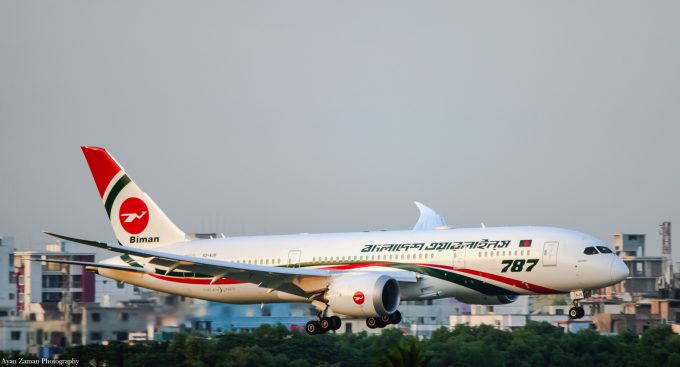Bangladesh looks at demurrage waiver as containers pile up in Chittagong
The Chittagong port yards now have close to 40,000 teu of containers, mainly loaded with ...
TFII: SOLID AS USUALMAERSK: WEAKENINGF: FALLING OFF A CLIFFAAPL: 'BOTTLENECK IN MAINLAND CHINA'AAPL: CHINA TRENDSDHL: GROWTH CAPEXR: ANOTHER SOLID DELIVERYMFT: HERE COMES THE FALLDSV: LOOK AT SCHENKER PERFORMANCEUPS: A WAVE OF DOWNGRADES DSV: BARGAIN BINKNX: EARNINGS OUTODFL: RISING AND FALLING AND THEN RISING
TFII: SOLID AS USUALMAERSK: WEAKENINGF: FALLING OFF A CLIFFAAPL: 'BOTTLENECK IN MAINLAND CHINA'AAPL: CHINA TRENDSDHL: GROWTH CAPEXR: ANOTHER SOLID DELIVERYMFT: HERE COMES THE FALLDSV: LOOK AT SCHENKER PERFORMANCEUPS: A WAVE OF DOWNGRADES DSV: BARGAIN BINKNX: EARNINGS OUTODFL: RISING AND FALLING AND THEN RISING

Biman Bangladesh Airlines is hoping to lure some of the 90% of cargo traffic from its home country it does not carry, by bringing in freighters.
Airlines have reported seeing more traffic in Bangladesh, and carriers including AirBridgeCargo have been considering launching routes to Dhaka, which is a key apparel exporter.
Biman is expected to publish a report into the viability of freighter operations this month, after it formed a committee in December.
The air cargo market in Bangladesh is thought to be worth about $358m, of which 90% is carried by foreign carriers, including Emirates, Etihad, Qatar, Cathay and China Southern. One of the biggest problems for carriers and exporters has been air cargo security, but sources have said it is improving.
Biman’s general manager for public relations, Shakil Manager, told the country’s Financial Express newspaper: “The committee will look into the areas like market potential for freighter operation, profitable routes, manpower, equipment and operating cost.”
One of the potential problems is a weak network, but the carrier, which has 15 aircraft, has an agreement to operate at least two daily cargo flights to Asia.
According to the Financial Express, Bangladesh’s authorities have been reluctant to launch a home-grown freighter service, claiming they have an “unholy nexus with foreign carriers”.
But exports from Bangladesh have grown recently, possibly boosted by US tariffs on China’s exports.
“We are definitely seeing more demand out of South-east Asia, especially Taiwan, Singapore, Bangladesh and Vietnam,” said Volga-Dnepr sales and marketing chief Robert van de Weg.
“It’s likely to be a combination of tariffs, and normal movement. China is becoming more expensive so companies are moving anyway – but tariffs have accelerated it. People want to be prudent, and to diversify no matter what happens.”
Last year, Bangladesh was the second-largest global apparel exporter after China, sending out $30bn-worth of garments from 4,500 factories, and it aims to have a $50bn-a-year industry by 2023.
Volumes could be significantly down this week, however. Some 52 garment factories are temporarily closed following widespread protests by their workers in a dispute, now entering its second week, over a new wage structure. yesterday, the government agreed to new wages but there remains some unrest, according to local media. It is not yet known how the export market will be affected by the closures, some of which include big factories.
Comment on this article